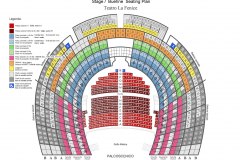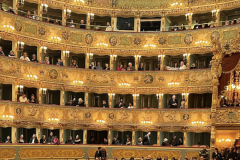Otello
Mo | Tu | We | Th | Fr | Sa | Su |
Synopsis
Place: Venice
Time: End of the 18th Century
According to the booklet of the Milanese representations of 1818.
"Otello, African to the service of Adria (Venice), victor returns from a battle against the Turks. A secret wedding ties him to Desdemona, daughter of his enemy, Elmiro Patrizio Veneto, already promised to Rodrigo, son of the Doge. Jago, another frustrated lover of Desdemona and hidden enemy of Otello, in order to be revenged of perceived wrongs, pretends to favor the love-suit of Rodrigo; an intercepted letter of the latter, by means of which Otello is led to believe his wife unfaithful, forms the texture of the action, which ends with the death of Desdemona, pierced by Otello, leading him to go mad, after uncovering the deceit of Jago and the innocence of his wife.”
Act I
The general Otello returns victorious from Cyprus to Venice. He is secretly with Desdemona, the daughter Elmiros, married and hopes to sanction this connection by his success. Rodrigo, the son of the Doge, Desdemona wants to marry his hand and spins with Iago, who has come into possession of a compromising letter Desdemona, a plot against Othello. Desdemona is waiting with her confidante Emilia in Otello. She is worried about his affection, because her father has intercepted a letter to Otello and it has not received any letters from Otello more. Elmiro, meanwhile, has decided to marry Desdemona with Rodrigo. The wedding celebrations begin, but Desdemona, refuses to marry Rodrigo. Otello interrupts the celebration and announced that he loves Desdemona, the Mad Elmiro leads his daughter away and there is a first confrontation between Otello and Rodrigo.
Act II
Rodrigo strikes Desdemona in the garden, she confesses to him to be already married with Othello and asks him to appease her father, but Rodrigo threatens to punish Otello. Desdemona is committed Emilia that she has revealed her secret, she fears losing Otello's love. Emilia guess the fate and decides to bring friends of Desdemona. Otello confides in Jago and required by this evidence of Desdemona's infidelity. Iago gives him Desdemona's letter, and Otello thinks this is intended for Rodrigo and he swears revenge. Rodrigo wants to reconcile with Otello, but he rejects him. Desdemona enters and now they accuse both Otello and Rodrigo of infidelity. Desdemona is distraught because she's behavior Othello can not explain; when the two men leave to fight a duel, she faints. Emilia finds her and warns her in vain before the impending disaster. Friends Tell Desdemona, Othello that has survived the duel with Rodrigo. Elmiro comes to it; he sees his honor violated and violates Desdemona.
Act III
Desdemona with Emilia alone in her bedroom in Elmiros house. While Emilia tries to comfort Desdemona, the song of a gondoliers what Desdemona again reminded of their calamity is heard outside. She sings to the harp than lament the willow song. After Emilia, Desdemona has sent away and put to sleep, Otello comes through a secret door into the room to kill Desdemona. At the sight of the sleeping he is indeed uncertain, but as Desdemona talks in her sleep by her lover, he believes that Rodrigo is meant. Desdemona awakens, she recognizes the intrigue Iago, Othello but indicated their response again wrong and he stabs her. Lucio, a supporter Otello reported this that Rodrigo meanwhile killed Jago and that this had been his intrigue before his death. The Doge, Elmiro and Rodrigo happen. Rodrigo pulls his claims back to Desdemona and Othello Elmiro will give his daughter's hand now. Then finally recognizes Otello his mistake and he kills himself.
Program and cast
Otello Francesco Meli
Dedsdemona Francesca Dotto
Jago Luca Micheletti
La Fenice Fenice Orchestra & Coro
Conductor: Myung-Whun Chung
Chorus master: Alfonso Caiani
Direction: Fabio Ceresa
For the Opening Opera night Season on Wednesday, November 20, 2024, black tie is required
Teatro La Fenice
Teatro La Fenice ("The Phoenix") is an opera house in Venice, Italy. It is one of the most famous theatres in Europe, the site of many famous operatic premieres. Its name reflects its role in permitting an opera company to "rise from the ashes" despite losing the use of two theatres (to fire and legal problems respectively). Since opening and being named La Fenice, it has burned and been rebuilt twice more.
The Teatro La Fenice was founded in 1792. In the nineteenth century, the theatre staged the world premieres of numerous operas, including Rossini’sTancredi, Sigismondo and Semiramide, Bellini’s I Capuleti e i Montecchi (The Capulets and the Montagues) and Beatrice di Tenda, Donizetti’sBelisario (Belisarius), Pia de’ Tolomei, and Maria de Rudenz, and Verdi’s Ernani, Attila, Rigoletto, La traviata and Simon Boccanegra.
In the last century, the Fenice has also placed a special emphasis on contemporary productions, welcoming the world premieres of Stravinski’s The Rake’s Progress, Britten’s The Turn of the Screw, Prokofiev’s L’angelo di fuoco (The Fiery Angel), Nono’s Intolleranza (Intolerance) and Maderna’s Hyperion. Recent premieres have included Kagel’s Entführung im Konzertsaal (Kidnapping in the Concert Hall), Guarnieri’s Medea, Mosca’s Signor Goldoni and Ambrosini’s Il killer di parole (The Killer of Words).
With a seating capacity for over one thousand people, the Fenice boasts excellent acoustics (which were improved when the theatre was rebuilt after the devastating fire of 1996), a 98-member orchestra and 66-person opera chorus, a dedicated local audience and a large international following. The theatre is a leading creative venue, staging more than one hundred opera performances per year, a major symphonic season conducted by prominent conductors from across the globe (including frequent collaborations with Myung-Whun Chung, Riccardo Chailly, Jeffrey Tate, Vladimir Temirkanov and Dmitrij Kitajenko), the full cycles of symphonies by Beethoven, Schumann, Brahms and Mahler, a contemporary repertoire focused especially on Venetian artists such as Nono and Maderna, ballets, and chamber music concerts.
The theatre is owned by the Municipality of Venice and managed by the Fondazione Teatro La Fenice, a private body whose members include the State of Italy, the Veneto region, the Municipality of Venice and numerous public and private institutions. The foundation also runs a second theatre, the Teatro Malibran (formerly known as the Teatro di San Giovanni Grisostomo), which dates back to 1678.
The leadership of the Fondazione includes General Manager Cristiano Chiarot, Artistic Director Fortunato Ortombina, Principal Conductor Diego Matheuz and Chorus Master Claudio Marino Moretti.
Transport
Vaporetto
from Tronchetto: line 2
toward Rialto bridge, St Mark and Lido
from Piazzale Roma and the Santa Lucia train station: line 1 or line 2
toward Rialto bridge, St Mark and Lido
stops: take line 1 to Rialto bridge, St Angel, St Samuel or St Mark (Vallaresso);
or take line 2 to Rialto bridge or St Mark (Vallaresso)
Alilaguna public transportation service from the Marco Polo airport - take the orange line to Rialto bridge or the blue line to St Mark (Vallaresso)
Parking: although you can drive to Venice, cars, bicycles and mopeds are not permitted in the city. You can leave your vehicle in one of the parking garages on Tronchetto or in Piazzale Roma:
Entrances
La Fenice Opera House has two entrances:
- the stage door is for theatre staff and performers only and is manned by a doorman;
- the main entrance
Lifts
The boxes, gallery and family circle can be reached via elevators
Access
The theatre complies with all legal regulations regarding special needs accessibility.

 EN
EN DE
DE IT
IT FR
FR ES
ES RU
RU JP
JP RO
RO Seating plan
Seating plan 